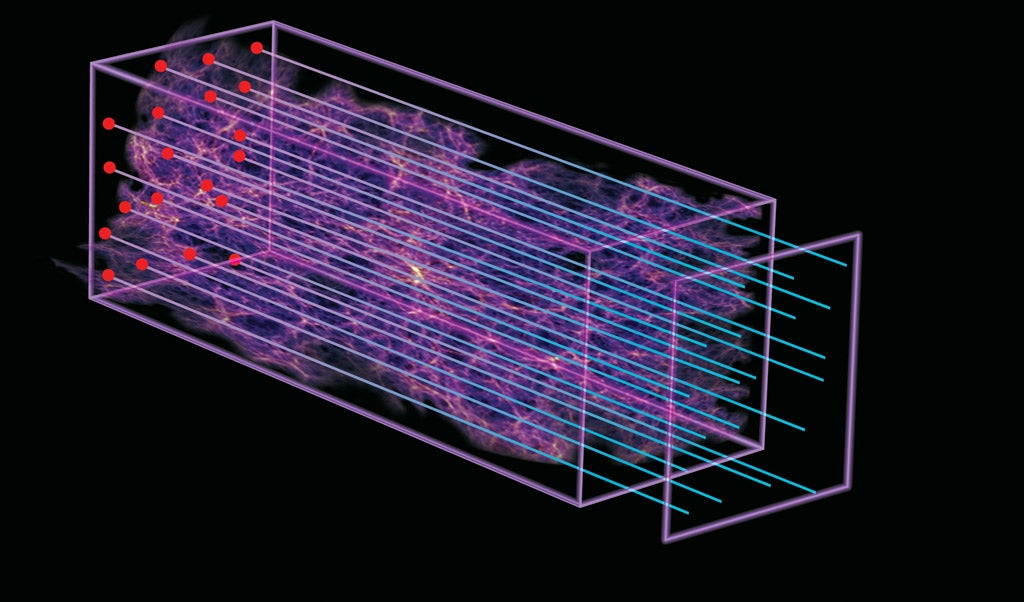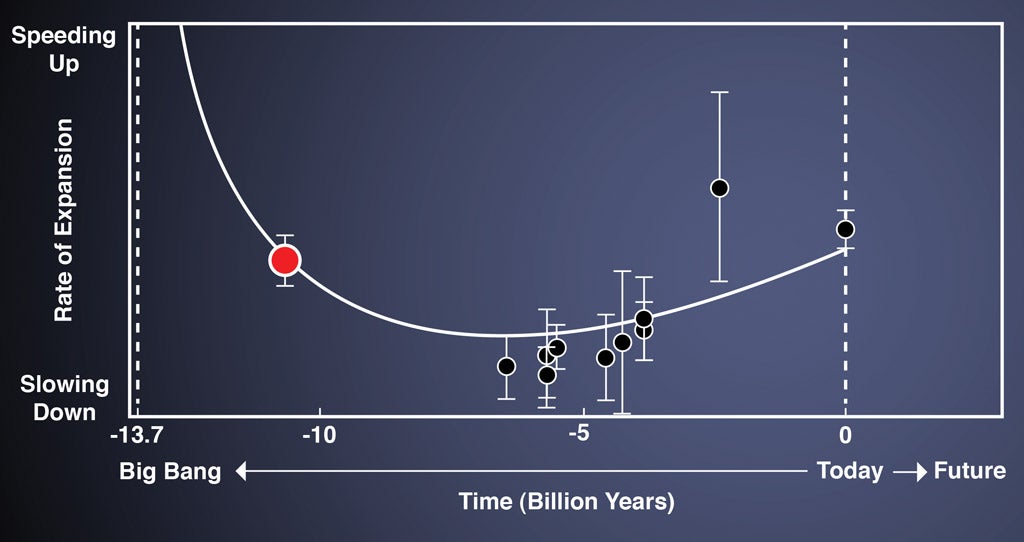“If we think of the universe as a roller coaster, then today we are rushing downhill, gaining speed as we go,” said Nicolas Busca of the Laboratoire Astroparticule et Cosmologie of the French Centre National de la Recherche Scientifique (CNRS), one of the lead authors of the study. “Our new measurement tells us about the time when the universe was climbing the hill — still being slowed by gravity.”
The new measurement is based on data from the Baryon Oscillation Spectroscopic Survey (BOSS), one of the four surveys that make up SDSS-III. It utilizes a technique pioneered by the SDSS in 2005 called baryon acoustic oscillations (BAO). The BAO technique uses small variations in matter left over from the early universe as a “standard ruler” to compare the size of the universe at various points in its history.
But using that ruler comes with its own difficulties. “If we want to make a measurement at early times, then we need to map structure that is very far away,” said Jim Rich of the Centre de Saclay Institute of Research into the Fundamental Laws of the Universe (IRFU), another member of the analysis team. “If we used galaxies, it would be very hard because galaxies that are far away are also very faint. So we have to try something else.”
The new measurement does not look at galaxies at all. Instead, it makes use of the clustering of intergalactic hydrogen gas in the distant universe. Scientists can see this gas because it absorbs some light from quasars lying behind. When they measure the spectrum of a quasar, they see not only the light emitted by the quasar, but also what happened to that light in its long journey to Earth. When astronomers look at a quasar’s spectrum, they can see how the intervening gas absorbs some of the quasar’s light. Measuring this absorption — a phenomenon known as the Lyman-alpha forest — yields a detailed picture of the gas between Earth and the quasar.
“It’s a cool technique because we’re essentially measuring the shadows cast by gas along a single line billions of light-years long,” said Anze Slosar of Brookhaven National Laboratory in New York. “The tricky part is combining all those one-dimensional maps into a three-dimensional map. It’s like trying to see a picture that’s been painted on the quills of a porcupine.”
Last year, Slosar and his colleagues used the first 10,000 quasars from SDSS-III’s BOSS to make the first large-scale map of the structure of the faraway Lyman-alpha forest gas. As enormous as that map was, it was still not large enough to detect the subtle variations of BAOs. But the new map is big enough — it measures the Lyman-alpha forest using light from 50,000 quasars all over the sky.
The team’s new measurement of the BAO peak, combined with measurements of the same peak at other points in the universe’s history, paints a picture of how the universe has evolved over its history. The picture that emerges is consistent with scientists’ current understanding of the universe — that dark energy is a constant part of space throughout the cosmos. What is fascinating about the new result is that, for the first time, astronomers see how dark energy worked at a time before the universe’s current acceleration started.
“Our goal for BOSS was to measure the expansion of the universe. We planned to make that measurement in two ways — one a sure thing and one a risky new idea,” said University of Utah astrophysicist Kyle Dawson, the BOSS survey scientist who ensures that good data is taken for each of the 1.8 million galaxies and quasars that BOSS will observe during the six years of SDSS-III. “It’s really exciting that, thanks to the dedicated work of so many people, we know that both methods work. We have shown that the Lyman-alpha forest can accurately measure the expansion of the universe when it was only one-fifth its current age.”
The BOSS measurements show that the expansion of the universe was slowing down 11 billion years ago due to the mutual gravitational attraction of all of the galaxies in the universe — but that as the universe expanded, the constant repulsive force of dark energy began to dominate as matter was diluted by the expansion of space. Thus, more than 80 years after Edwin Hubble and Georges Lemaitre first measured the expansion rate of the nearby universe, the SDSS-III has made the same measurement of the expansion rate of the universe 11 billion years ago.
“No technique has ever been able to probe this ancient era before,” said BOSS principal investigator David Schlegel of the Lawrence Berkeley National Laboratory in California. “Back then, the expansion of the universe was slowing down; today, it’s speeding up. How dark energy caused the transition from deceleration to acceleration is one of the most challenging questions in cosmology.”
SDSS-III will continue to learn more about dark energy as it collects more than a million and half galaxies and more than 160,000 quasars by the end of the survey. By the time SDSS-III is complete, it will have helped transform the Lyman-alpha forest technique from a risky idea into a standard method by which astronomers explore the nature of the faraway Universe.
Nicolas Busca summarized: “It looks like the roller coaster crested the hill just about 7 billion years ago, and we’re still going.”











